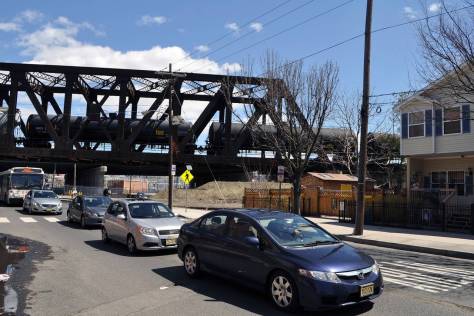Repost from McClatchyDC News
Rail defect, tank car valves implicated in West Virginia oil train fire
By Curtis Tate, April 16, 2015WASHINGTON — Outlet valves underneath four tank cars in a February oil train derailment in West Virginia were sheared off and the 50,000 gallons of crude oil they released ignited in a fire that subsequently caused several nearby rail cars to explode, according to a federal report.
The report also identified the initial cause of the Feb. 16 derailment in Mount Carbon, W.Va., as a broken rail on track owned and maintained by CSX and said more than 362,000 gallons of crude oil were released. The fires and explosions from the derailment kept 300 residents away from their homes.
The report, which appeared Thursday in the Pipeline and Hazardous Materials Safety Administration’s hazardous materials incident database, highlights another issue with the design of the tank cars used to carry crude oil and their ability to resist damage from derailments and fire exposure.
The Mount Carbon derailment was one of four oil train derailments since the beginning of the year that resulted in large fires. On March 5, an oil train operated by BNSF derailed near Galena, Ill. Two other oil trains derailed in Ontario on Canadian National, one in February and one in March.
Last week, the National Transportation Safety Board issued recommendations that tank cars used to transport flammable liquids must have thermal insulation to protect them from the kind of fire exposure that can result in explosions.
Federal regulations require tank cars to survive 100 minutes of fire exposure. However, eight tank cars failed within 90 minutes after the derailment, their contents exploding in giant fireballs, according to the NTSB.
The NTSB recommendations did not address the apparent cause of the initial fire: the failure of the bottom valves on the cars used in unloading.
A set of new regulations on tank car construction the government may release in the next few weeks include requirements to remove bottom valve handles or to protect them from opening in a derailment. But they would not require the valves’ removal altogether.
Removing the valves would mean expensive modifications at unloading facilities that have popped up across the country as a surge in energy production has moved by rail in recent years.
Members of Congress impatient with the pace at which new regulations have moved have begun introducing legislation to require more robust tank car construction. Regulators and lawmakers also are pushing for increased track inspections.
The particular type of internal defect that led to the broken rail in West Virginia, called a vertical split head, can be difficult to detect with a visual inspection, according to Sperry, a company that makes vehicles that perform ultrasonic rail inspections.
Federal law requires that railroads inspect most mainline track twice a week, with at least one calendar day between inspections. A CSX regional vice president told reporters a day after the derailment that the track in Mount Carbon had been inspected three days earlier.
Rob Doolittle, a CSX spokesman, said in an email Thursday that the company looked forward to learning more about the Federal Railroad Administration’s accident investigation.
“Safety is CSX’s highest priority and we carefully evaluate the ascribed cause of each incident to apply whatever lessons are available to make our operations safer,” he said.





You must be logged in to post a comment.